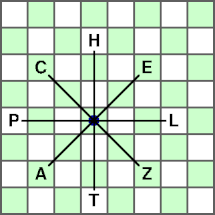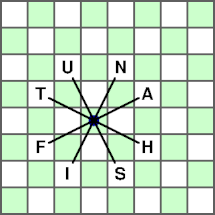The Colonel's Guide to Smythescript
In response to the overwhelming demand for information about
Smythescript, here is a copy of my article in
Chess Chow.
The editor has
not authorized me to publish it, but then I didn't authorize him to
copy it off rec.games.chess in the first place, much less to
characterize Smythescript as
a truly sadistic way to keep score.
So here once again, for those of you who are fed up with the ambiguity
and dryness of algebraic notation, is a summary of Smythescript:
-
A move consists of any or all of these in sequence:
- a man specifier
- a disambiguator
- a direction
- a castling specifier
- a distance
- a capture specifier
- a promotion specifier
- a check specifier
- Use disambiguators only when necessary.
- Write each move as briefly as you can without violating rule 2.
- Neither a direction nor a distance may be used without a man specifier.
- A castling specifier must stand alone.
- Pieces are specified as 0 for a king,
8 for a queen,
5 for a rook,
3 for a bishop,
and 7 for a knight. The digits are intended as crude
representations of the conventional symbols.
- Pawns are specified by the files on which they stand: from queen's rook
to king's rook,
T, U, N,
A, F, I,
S, H.
- A player's men with the same specifier may be disambiguated by
appending one or more Xs:
one X
for the first such man on the board, two for the second, and so
on, where the men are numbered as they are encountered in a scan of the board
from Black's queen's rook square to his king's rook square, then from
Black's queen's rook's second square to his king's rook's second square,
and so on to White's king's rook's square.
- A direction for any piece but a Knight
is any of the following: C for diagonally towards
Black's queenside, H for vertically towards Black,
E for diagonally towards Black's kingside,
L for horizontally towards the kingside,
P for horizontally towards the queenside,
A for diagonally towards White's queenside,
T for vertically toward White, Z
for diagonally toward White's kingside.
A direction for a Knight is any of the following:
T for one square towards Black
and two towards the queenside, U for two squares towards
Black and one towards the queenside, N for two squares
towards Black and one towards the kingside, A for one
square towards Black and two towards the kingside, F
for one square towards White and two towards the queenside,
I for two squares towards White and one towards the
queenside, S for two squares towards White and one
towards the kingside, and H for one square towards
White and two towards the kingside.
- A direction for a pawn is: −
for one square forwards if the pawn can move two.
- A castling specifier is 4 for castling short
or 6 for castling long.
- A distance is a number from 1 to 7.
- A capture specifier is any of the following: D
for a capture en passant; J for a recapture;
K for any other kind of capture; a file specifier for
a capture, not en passant or a recapture, for a pawn that has another
capture.
- A promotion specifier is a piece symbol.
- A check specifier is W, for check or checkmate.
- 30 denotes loss by mate, resignation or forfeiture.
15 denotes a draw.
The preference rules for equally long representations need not concern us now.
In case you feel you're not ready to tackle the
Fischer—Spassky games yet, here's an easy one to start with.
Alekhine's Defense. Eberlein—Seidman, New York State Championship,
Syracuse 1971. 1. F 7XXI 2. F 7F
3. A A 4. 7XXU S− 5. N 7T 6. K NJ 7. 7XXN
3XX1 8. H− 4 9. 3E2 7XS 10. 8H1 F 11. 6 FK 12. 7J A 13. NK 7J 14. 7UK J
15. 7K NJ 16. J 8W 17. 8P 8C 18. 8P1 3Z3 19. 83K 5L 20. U− 53W 21. 33 KW
22. J 3X4 23. 30
Send questions about Smythescript to its inventor,
Bill Smythe,
not to me!
Historical background.
A tunafish is a fish who habitually slaughters
national masters at five-minute chess. A chelpatz
is the inverse phenomenon: a national master who
habitually loses to patzers at five-minute chess.
Readers in the Chicago area may be able to identify the master in question.
Back to The Colonel's Chess Page
Col. G. L. Sicherman
[ HOME
| MAIL
]



